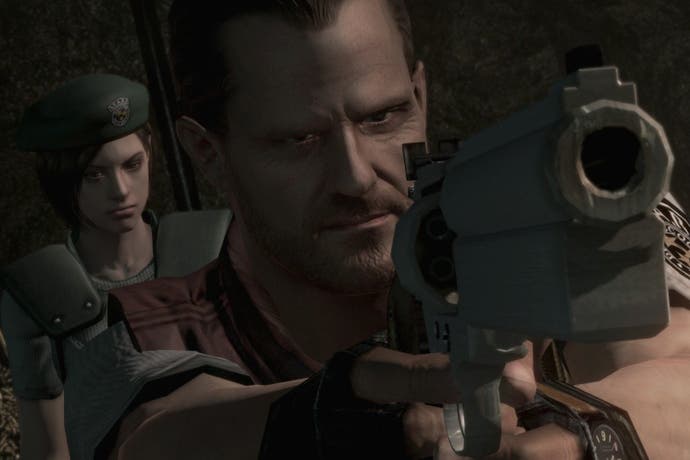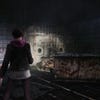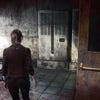Digital Foundry vs Resident Evil on PS4
Analysis of the upcoming remaster, along with Revelations 2.
Capcom's classic Resident Evil franchise returns, manifesting on current-gen consoles in the form of two releases in the first three months of 2015. First up, we're in remaster territory, with a full HD rendition of 2002's Resident Evil remake - enough to tide over fans until the March launch of the next major entry, Resident Evil Revelations 2. But to what extent is the more powerful Xbox One and PlayStation 4 hardware actually utilised in this brace of titles?
Though the jump from Resident Evil's 1996 debut to the 2002 GameCube remake is more pronounced, the remaster still has a great many plus points. While it hardly pushes the PS4 hardware, the remodelled characters chisel new details into Jill and Chris' in-engine designs, bringing them closer into line with expectations of a current-gen title. Capcom does a respectable job of staying faithful to the original renders, but still finds room to add new wrinkles, scars, and fabric patterns to their designs. It's a tangible upgrade, and close-ups show the extent of the change.
In fact, most polygonal 3D elements are updated over the GameCube release (and by extension the similar 'Archive' version for Wii, as used in our comparison shots). This goes for the main cast, the infected creatures of the mansion, swinging doors during scene transitions, and also inventory screen objects like guns or herbs. Promised to output at 1920x1080 at 30fps on PS4 and Xbox One (confirmed for the former based on our captures), it's these aspects in particular that benefit from a heightened pixel count, and come out sharpest.
However, the same approach is not always taken with its pre-rendered backdrops or video cut-scenes. In keeping with the template of the original PlayStation trilogy, backgrounds are typically drawn in as static scenes - the PS4 edition (tested here) tending to rely on the GameCube remake's backdrops. Outside of tweaks to colour balance, these match the original Nintendo release in terms of core detail, this time delivered at 1920x1080 to reveal the full extent of their original quality.
But are any backgrounds redrawn just for this HD release? Pixel-counting 2D art isn't easy, and from the game's opening areas there's clearly a mixture of approaches at play. Producer Yoshiaki Hirabayashi explains the remaster process is indeed arranged on a scene-by-scene basis, and that three different levels of treatment are used for each area, depending on the nature of the shot. In essence, some areas receive more elaborate upgrades than others, and it often shows.
First off, a good bulk of backgrounds are plucked directly from the GameCube remake, with the intention of staying faithful to the original tone and design of the original vision. However, some key areas are redrawn from scratch, such as the opening hallway to the mansion, decorated with chandeliers and a reflective marble floor. This scene is overlaid with a new, ebbing bloom effect across candles and lamps, and boasts a much improved lighting model for the flashes of the storm outside. On top of that, light sources also brighten characters directly as they walk past, where before they went mostly unaffected.
For this particular shot, the update shines through beautifully at 1920x1080. But in very rare instances the team goes full-blast, producing entirely geometric replacements; an early cellar area (with a furnace at centre) receiving this top-grade treatment. The motive here is to avoid using the GameCube edition's pre-baked animations to simulate this room's flickering shadows - essentially a video file that plays in a loop. It's an approach that doesn't hold up by today's standards, replaced in this specific case by a true lighting model necessitating a full 3D backdrop to achieve a similar effect.
Tweaks are also made to specific instances of the game's plant-life, swaying to the wind in the foreground of certain cemetery shots. Rather than force the original, low resolution animations in front of the player, here too we get the geometric approach - this time running in front of a static background. All of this underlines the complexity of the project, and the need to build around its constituent parts to drive up quality.
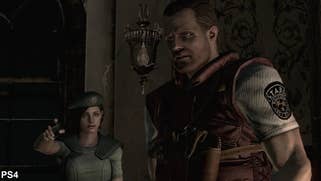
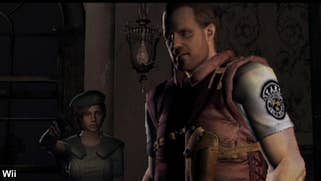
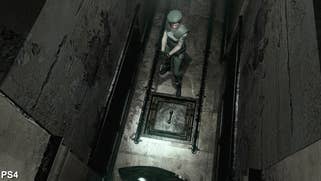
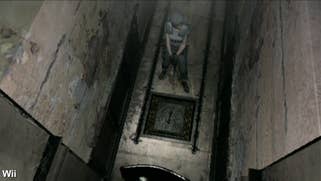




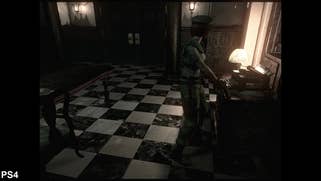


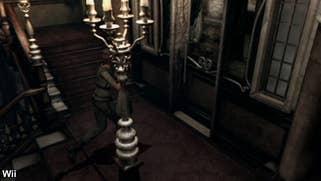
If only in part, Capcom's choice to work from the GameCube's static backdrops and videos makes sense. Short of redrawing every scene in the game once again, or rendering everything in full 3D, it's likely a more cost-effective approach. Unfortunately, some of these areas stand up to scrutiny at 1080p better than others; a deeper dive into the game's mansion flagging up some garish, low-res areas. As one early example, the texture maps on two moving walls (during one puzzle sequence) appear very raw and pixelated - the game's refined character designs sticking out by comparison.
Typically, areas such as this fare the worst. The end result is an uneven level of image quality between each shot, with geometric and redrawn scenes standing heads and shoulders above the reused assets. It's a similar story for the game's cut-scenes - in one moment, a simplified, pre-rendered Jill Valentine chases towards the mansion, and in the next, she appears in a new, fully embellished, in-engine render.
Given the nature of the project, this is partly expected, and it's debatable how much more would constitute a full-blown remake. Capcom promises a remaster here, and that's precisely what we're being handed - a definitive version of the best Resident Evil we know for a cut-down price. Coupled with a 5.1 surround sound mix and an optional new control scheme (with 'tank' controls still provided), changes to the core gameplay otherwise appear quite minimal - meaning fans of the original won't be disappointed.
One of the other major bullet-points of the remaster is also its 16:9 mode. Here, the game crops the tops and bottoms of each area to fill out the screen horizontally. It's not ideal, but Capcom makes the best of this approach by dictating which parts are cut from view (making sure character faces are framed in full, for example). It also has the camera pan to reveal different parts of the picture, based on where a character moves. All told, it's clearly a compromise, but these adjustments help to minimise the waste of pre-rendered detail. Of course an original 4:3 mode is still available for the purists.
As for this being the series' first steps on current-gen, it's not a technical showcase for PS4 as an outright remake from the ground up might have been. The 30fps playback on PS4 is a curious point, especially given how little is being rendered on-screen in terms of actual geometry, physics, and effects-work. But given the relatively slow pace to its action, and the fixed camera, a full 60fps refresh isn't necessarily a huge loss in this case. Comparisons with the PC version (which does offer full frame-rate) could be enlightening.
Turning from past glories to future prospects, the Resident Evil series strikes again later this year with the release of Revelations 2 on current and last-gen consoles - and PS Vita. With its first episode (of five) due out this March, we were fortunate enough to catch a brief demo of the game running on PS4. It's worth noting that this build dates back to a late 2014 showing, but it's nevertheless interesting to see its approach in utilising more modern hardware. The question going in is, as ever, is this the major current-gen Resident Evil we're looking for?
From a visual standpoint, the derelict prison setting puts a cap on just how much its engine can stretch its wings. First impressions suggest that cross-gen considerations are the priority, with newer hardware set to ramp up the resolution and effects quality. The PS4's native resolution is easy to count out at 1920x1080 here, but the low-grade textures, and also the repetitive, scripted animations, belie a truly progressive current-gen project.
Some neat touches are on show, like the per-object motion blur on hands mid-sprint, hair physics, and the gruesome model detailing on the infected. There's no guarantee of PS3 and 360 hitting these same, precise technical targets, but overall the game's level layout feels slightly sparse for a PS4 title, suggesting the benchmark might be set fairly low to favour these less capable consoles. Incidentally, for Vita owners, this might prove to be a good omen for performance in the upcoming handheld port.
As a plus, it's also pleasing to see a 60fps target for PS4, cut short of prestige by some protracted drops to 50fps. Putting our frame-rate analysis tools to work on this build - which may well improve significantly come its March release - the cause is often as simple as catching the full view of a dusty hallway, and drops to the mid 40s are on record without an infected creature in sight. Early signs point to Revelations 2 not being the perfect vision of a current-gen game then, but one that's still poised to bolster its visuals over last-gen to a respectable degree.
Based on the insights of these two games, current-gen consoles can expect to receive a rock-steady, if unspectacular, landing for the Resident Evil series designed perhaps with purists in mind. Overall, the HD delivery of the original holds up well on PS4 with its full 1080p picture, which should represent a decent step up from the 720p last-gen versions, also set for release later this month. The sense that cross-gen development is influencing the scope of these projects - especially in Revelations 2's case - is difficult to shake off though. The wait for a truly next-gen Resident Evil experience for PS4 and Xbox One continues then, but this double-bill of survival horror action should serve as an engaging stop-gap for franchise fans in the meantime.
